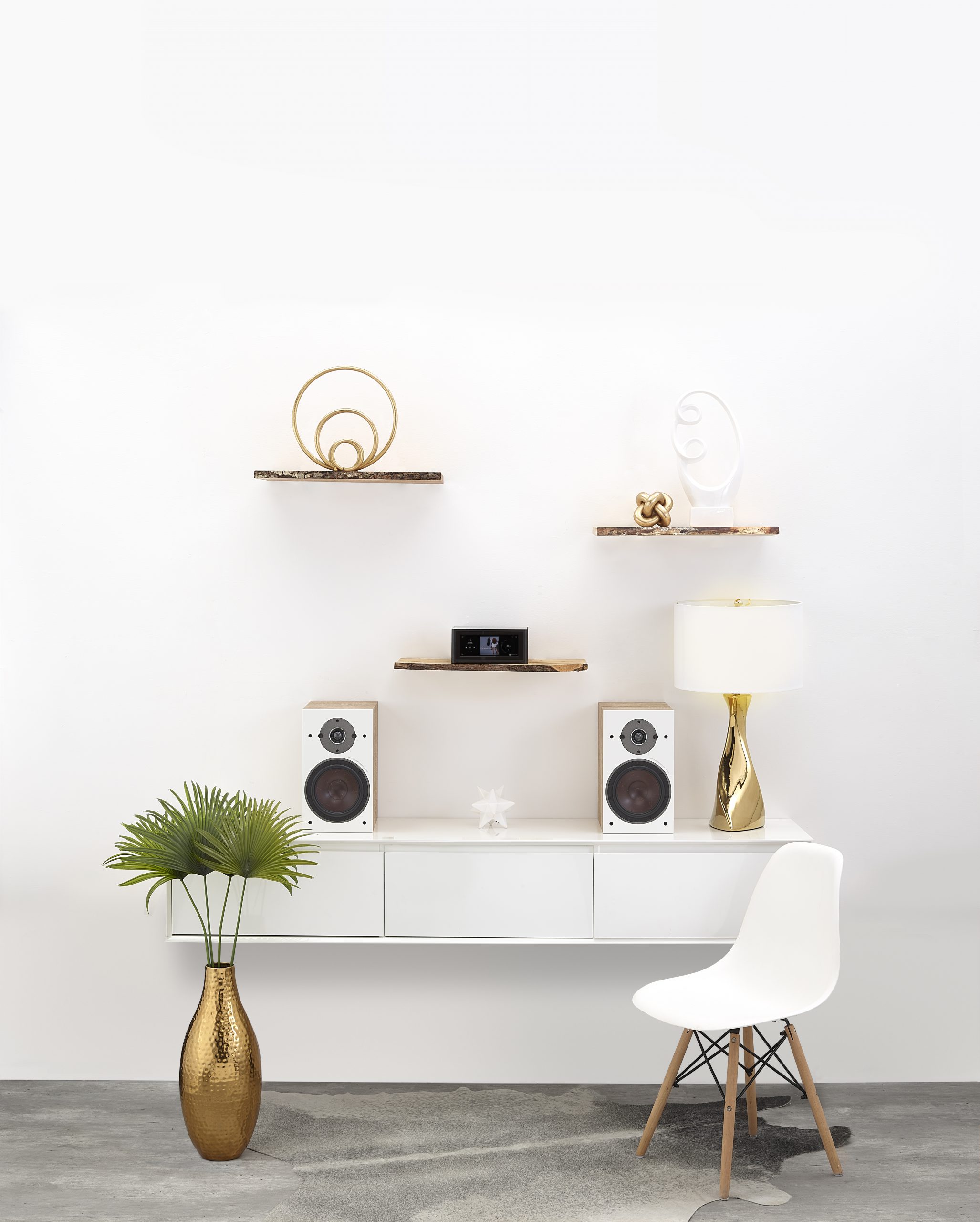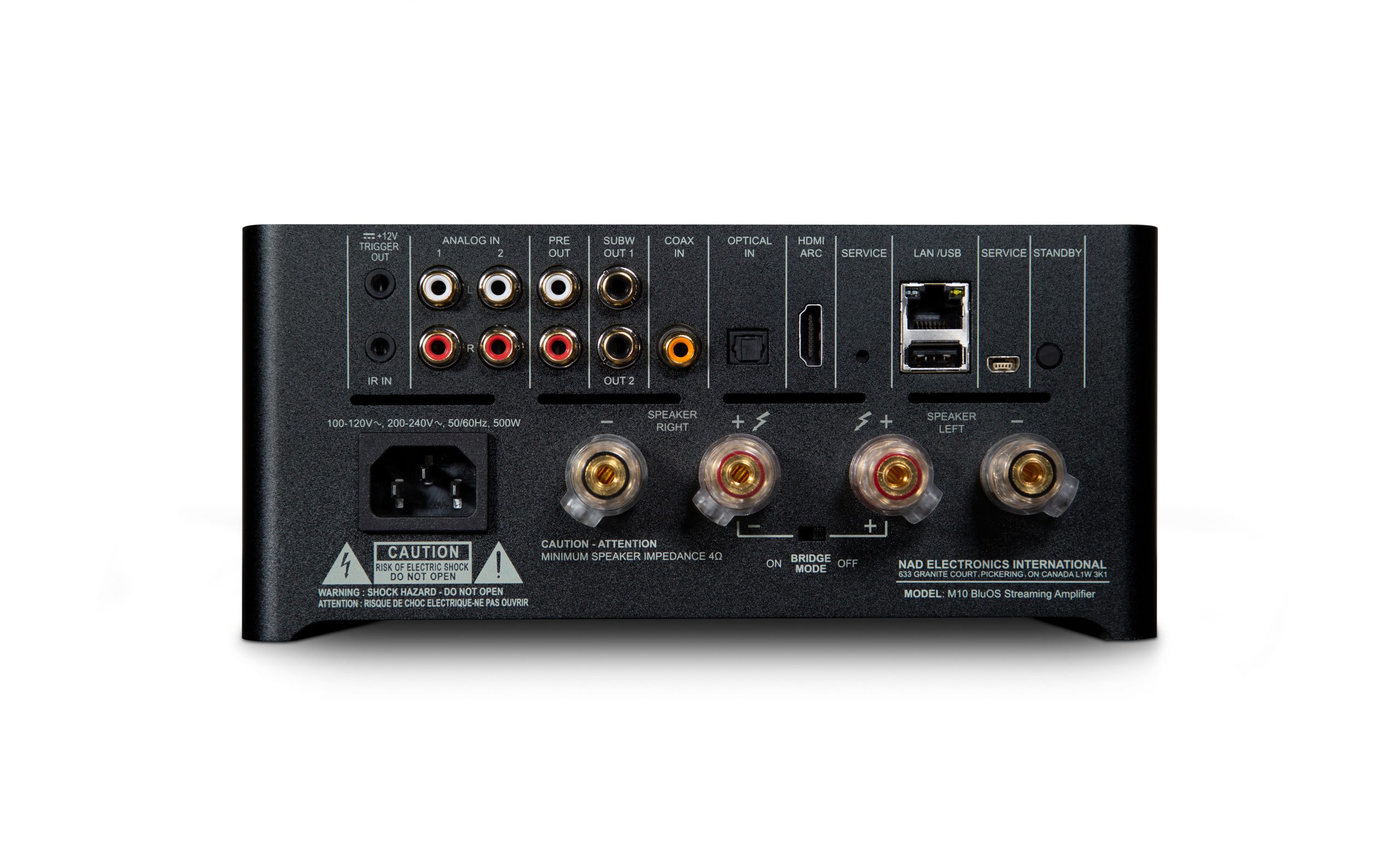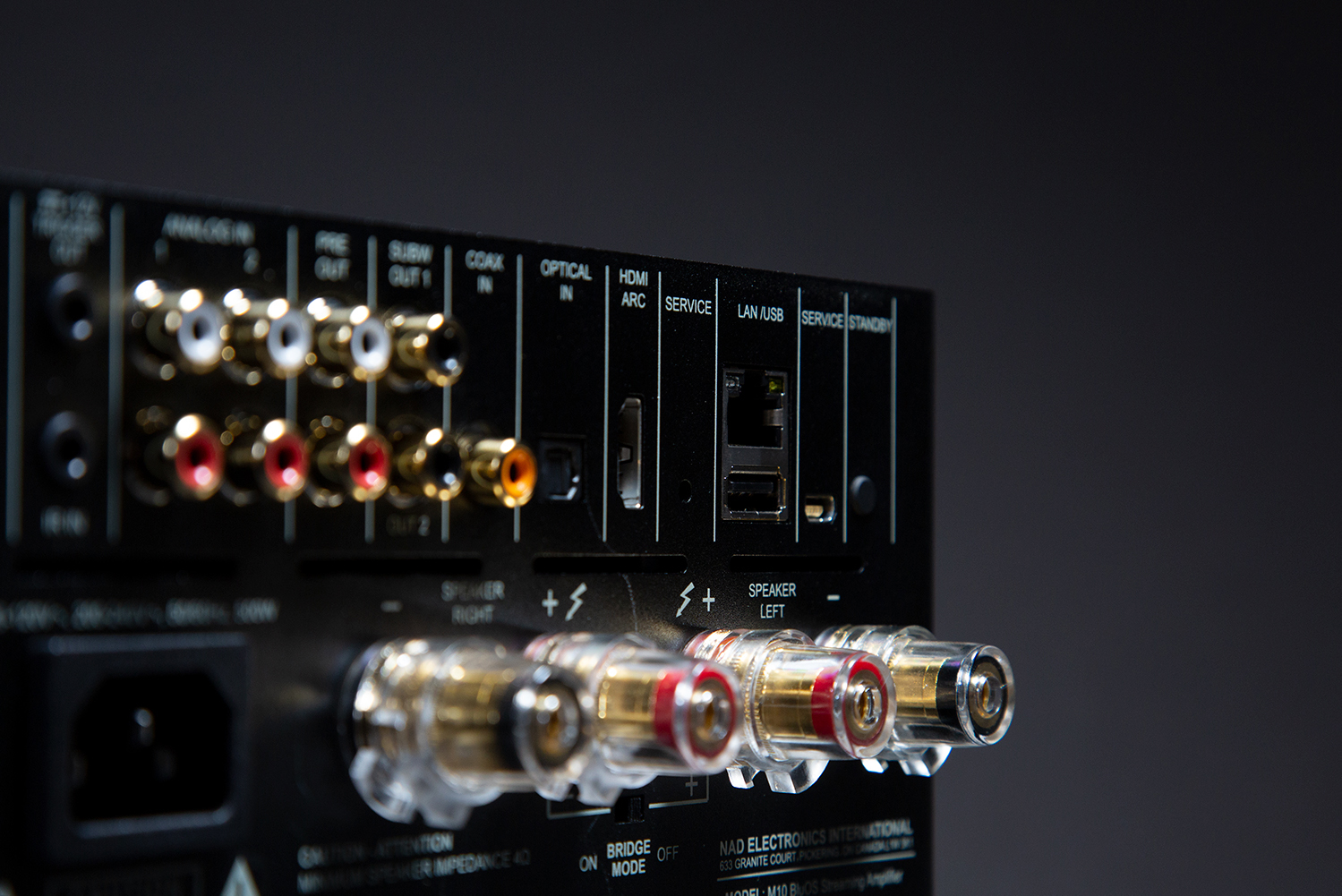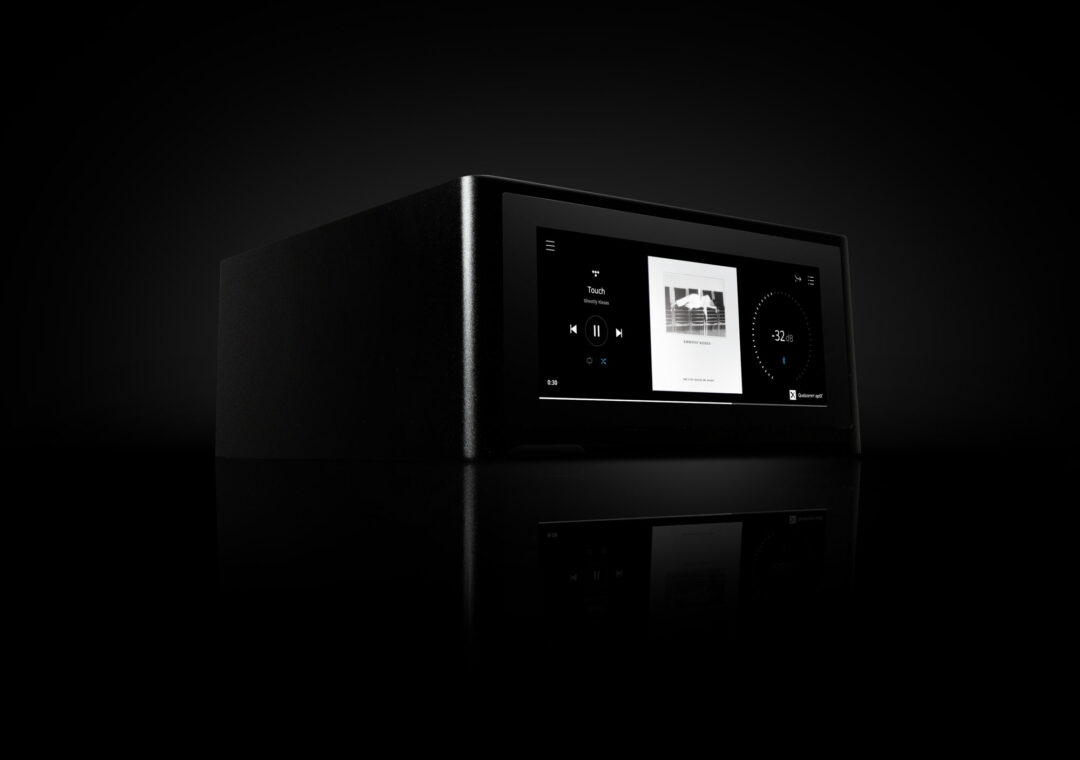NAD’s Masters series are the products where engineers are given free rein to make the best equipment they can. We have tested a number of products from the series, among them the integrated amplifier M32 and the media server M50.2.
The newest member of the family, the NAD M10, does not look like his older brothers. Instead of the classic 43 centimeter hi-fi format, the M10 is only 21.5 cm – that is, exactly half as wide. This is a 2 x 100 W integrated amplifier with a full set of digital and analog inputs as well as built-in BluOS functionality. This means that it can play all the most popular streaming services, and that it can be incorporated into a Bluesound multi-room system.
Similar to NAD’s tradition, the power amplifier part of the M10 can be bridged to 200 W mono. Interestingly, there is no matching pure power amplifier in NAD’s program that can handle the other channel, but we almost have to expect NAD to have one on the stairs. There is also a set of Pre Out / Main in connectors for connecting a larger power amplifier or a surround processor.

Decor-friendly
The NAD M10 does not make much of itself when it sits on top of the stereo. But it is also not where one would normally put it. The small unit is designed to be pushed into a bookcase or to stand on a sideboard. When the appliance is switched off, the entire surface is high-gloss black. Because when you turn it on with a touch, the entire glass front lights up in a touch display. The operation is quite logical, and it is easy to select inputs, adjust volume or change settings of, for example, tone controls or room correction.
Unlike the other Masters components, the M10 has no physical remote control. It’s not a big problem, and with the many features that can be controlled, I can well understand it if NAD has considered that the only way to get everything is via the BluOS app. And at the same time I have to praise the way the M10’s functions have been integrated into the app. But it would still be convenient to have a remote control at hand to pause the music, change the song and turn up or down the volume. All this can of course also be done from the touch screen in the front.
All formats – except vinyl
NAD M10 masters a full range of file formats, including MQA. This is especially interesting in connection with streaming from Tidal HiFi, which uses the format to provide HD sound on some of the albums being streamed. In return for MQA, other Masters devices have had to do without playing DSD files. But the M10 supports both. It is generally difficult to find an unsupported hi-fi music format. Except for vinyl records. If you want to use a turntable with the NAD M10, you need to invest in an external RIAA amplifier.

Room correction
We have said it before, and we will say it again: The “component” in the system that has the greatest influence on the sound is neither the amplifiers, the speakers nor, for that matter, the power supply. Staining from the listening room affects more than anything else.
Therefore, it is exciting news that the NAD M10 has built-in room correction. It happens in the form of Dirac Live. In its simple version, it can be downloaded as an app for PC, Mac, iOS and Android. Once installed, the more advanced version can be downloaded from the NAD website.
The correction is made using a measuring microphone of the same type that comes with better surround receivers. You can choose between letting the correction cover an entire sofa or just the razor-sharp sweet spot in the easy chair.
It takes about 10 minutes to measure the room with Dirac Live. A total of nine measuring points must be measured in the room around the listening position. A moment later, the program has calculated a correction curve, which is stored in the device itself. You can save two layouts at a time.
Room correction is fine, and it can in most cases correct unevenness in the frequency response, especially in the bass. But it helps most those who help themselves: If you choose to decorate modern with bare walls, large glass areas and tiled floors, even the best room correction falls short.
The sound quality
NAD M10 looks like a trinket, but for around 25,000 kroner you can demand more. And it fulfills it. It does not have quite the same crystal clear openness as its big brother M32, but it still draws the acoustic scene beautifully, wide and deep. It is experienced, for example, on Ivin from Afenginns Klingra, who excels with some outstanding recordings of piano and percussion, which sounds very open in the room. Here it’s like having the orchestra standing behind a (thin) curtain in the living room.
M10 can also manage to convey a denser atmosphere. On Medelin from Madame X, the Latin American clubbeat is hot when Madonna takes the 35-year-younger rapper Maluma under loving care. The vocals are obviously strongly treated, but are still completely clean in the room. The electronic base is solid, but fails to control the slightly heavy-duty Buchardt S400 that more powerful amplifiers can.
The Dirac Live room correction works pretty brilliantly! My listening room is relatively well subdued, but there are still some room resonances that are difficult to get rid of. Without room correction, the sound was excellent and with good definition. But with the correction turned on, the perspective falls into place, and the space behind the speakers becomes larger and wider. At the same time, the sound was also a little less close and cash, but there is no doubt that the sound after the correction is the most correct!
NAD M10 belongs to the small class of super-exclusive mini-systems, where you will also find Auralic Polaris and Naim Uniti Atom. Compared to the Auralic, the M10 is almost cheap, and it passes both in terms of features and beauty.

Conclusion
NAD M10 is a charming little guy who can help break down some prejudices about what to expect from a small, decorative mini-facility. The system combines a sound quality that can compete with adult systems, but at the same time with convenience that we are used to from multi-room systems. Which it can also be part of. There is something for everyone: DSD and MQA playback for the enthusiasts – and room correction to ensure that the system can sound good, even if the speakers are put away and not allowed to dominate the living room. The price is solid, but you get value for all the money.

We think
Room correction, streaming and MQA. The NAD M10 is packed with features that are rare in this class. After all, raw ironing is limited. No physical remote control. No RIAA input. It does not impress the neighbor.
2199 €
Specifications
- Output power: 2 x 100 W in 8 ohms / 2 x 100 W in 4 ohms, class D
- Digital inputs: coaxial, optical (Toslink), HDMI / ARC, USB Type A, Ethernet
- Analog inputs: 2 x line in (stereo RCA)
- Wireless: Wifi, AirPlay 2, Bluetooth 5 (aptX), Tidal, Spotify Connect, Deezer, TuneIn and more.
- Outputs: 1 pair of speakers (banana / screw terminals), 1 x pre out (stereo RCA), 2 x subwoofer (RCA)
- Resolution: 24-bit / 192 kHz
- Media formats: mqa, flac, aiff, wav, alac, wma, wax, asx, mpeg4, aac, m4a, mp3, dsd
- Control: Bluesound app, voice control with Alex and Siri (via smart speaker), 12 V trigger in / out
- Dimensions / weight: 21.5 x 10.0 x 26.0 cm (WxHxD), 3.3 kg
- Finish: aluminum and glass
- Web: hifiklubben.no

